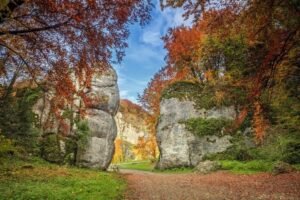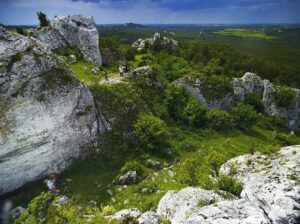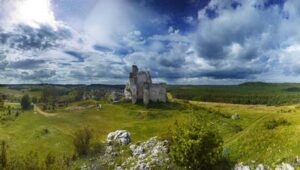The Kraków-Częstochowa Upland (Jura)
The Kraków-Częstochowa Upland (Jura), which is a part of the Silesia-Kraków Upland, comprises of a vast plate of Upper Jurassic limestone rising to an average of 300 m asl in the area of Częstochowa and to 400-500 m asl near Cracow. It is slightly inclined towards the North-East, where it gradually depresses underneath younger Cretaceous formations of which the Przedborska Upland and Nida Basin with its mesoregion Miechów Upland are built. From the North the Jurassic plate is indented by a gorge valley of the river Warta, which marks the border with Wieluńsko-Woźnicka Upland. In the South the Kraków-Częstochowa Upland is devided by the Biała Przemsza-Szreniawa tectonic depression into its mesoregions: Czestochowa Upland and Olkuska Upland, often called the Ojcowski Plateau.
Similiarly, the Kraków-Krzeszowice-Trzebinia tectonic depression (due to its extent deemed a mesoregion) where Krzeszowice Graben separates Olkuska Upland from Teńczyński Ridge, which descends towards the valley of the Vistula in the South, to be exact, towards the tectonic depression of Kraków Gate. It is a macroregion characterized by multiple geomorphological peculiar to other surrounding regions, including horst limestone hills. Hence the Kraków Gate is regarded by some scholars as part of the Kraków-Częstochowa Upland, which is reflected, for example, in the establishment of Jurassic landscape parks on its territory.
 From the West Częstochowa Upland falls into the Lowering the Upper Warta (Woźnicko-Wieluńska Upland) in a steep, reaching up to 100m asymmetric ridge, called cuesta. Less significant eastern boundary with the Lelowski Cuesta (Przedborska Upland) runs on the Mstów - Lelów - Pradła - Wolbrom line. Characteristic elements of landscape in Częstochowa Upland include Upper Jurassic limestone monadnocks, reaching several dozen meters and rising above the relatively flat level of its hilltops. They form large groups of rock, hillocks (like Janowski Mountain, the highest elevation of the Jura, of 515.5 m asl) and mountain ranges fragmented by valleys, generally dry, filled with sands, or draining water only periodically. Similarly, the Jura cuesta running irregularly between Olkusz and Trzebinia, lonely monadnocks sticking out on hilltops, with another Jura summit - Skałka 502 (512.8m asl) define Olkuska Upland. However, for the landscape of the southern part of the mesoregion characteristic are the stream valleys. Up to 100m deep, with steep, rocky slopes, they are commonly referred to as valleys of Kraków or the vicinity of Kraków. The most known and valuable is Prądnik Valley, within which Ojcowski National Park has been established. From among other valleys, lets mention only the nature reserves: Bolechowicka, Szklarki, Racławka Eliaszówka or one of the most famous tourist destinations, namely Będkowska Valley, and the longest of them Dłubnia Valley, which separates Olkuska Upland from Miechowska Upland. In western Olkuska Upland the valleys are intersected by older fromations. The Upper Jurassic limestones cut here reveal rocks of the Triassic, Permian (volcanic), Carboniferous and Devonian (Racławka Valley, Czernki, Miękinka and others) periods underneath. Tenczyński Ridge, stretching from Chechło Valley in the West to Kraków, has similar structure and terrain. In the western part there are, for example, Carboniferous formations containing black coal seams (Tenczynek) and hard volcanic rocks, which build hills. The highest among them is located in Rudno and crowned with the ruins of the castle Tęczyn (401.1 m asl). The surface of Tenczyński Ridge is intersected by numerous valleys, the most picturesque in the eastern parts, carved in the base out of Upper Jurassic limestones, as the Sanki Valley with Mnikowski Gorge. Tenczyński Ridge is a tectonic horst, constituting the pra-part of the Olkuska Upland plate, separated from it in the Tertiary by Krzeszowicki Graben. The area of this depression is flat,
From the West Częstochowa Upland falls into the Lowering the Upper Warta (Woźnicko-Wieluńska Upland) in a steep, reaching up to 100m asymmetric ridge, called cuesta. Less significant eastern boundary with the Lelowski Cuesta (Przedborska Upland) runs on the Mstów - Lelów - Pradła - Wolbrom line. Characteristic elements of landscape in Częstochowa Upland include Upper Jurassic limestone monadnocks, reaching several dozen meters and rising above the relatively flat level of its hilltops. They form large groups of rock, hillocks (like Janowski Mountain, the highest elevation of the Jura, of 515.5 m asl) and mountain ranges fragmented by valleys, generally dry, filled with sands, or draining water only periodically. Similarly, the Jura cuesta running irregularly between Olkusz and Trzebinia, lonely monadnocks sticking out on hilltops, with another Jura summit - Skałka 502 (512.8m asl) define Olkuska Upland. However, for the landscape of the southern part of the mesoregion characteristic are the stream valleys. Up to 100m deep, with steep, rocky slopes, they are commonly referred to as valleys of Kraków or the vicinity of Kraków. The most known and valuable is Prądnik Valley, within which Ojcowski National Park has been established. From among other valleys, lets mention only the nature reserves: Bolechowicka, Szklarki, Racławka Eliaszówka or one of the most famous tourist destinations, namely Będkowska Valley, and the longest of them Dłubnia Valley, which separates Olkuska Upland from Miechowska Upland. In western Olkuska Upland the valleys are intersected by older fromations. The Upper Jurassic limestones cut here reveal rocks of the Triassic, Permian (volcanic), Carboniferous and Devonian (Racławka Valley, Czernki, Miękinka and others) periods underneath. Tenczyński Ridge, stretching from Chechło Valley in the West to Kraków, has similar structure and terrain. In the western part there are, for example, Carboniferous formations containing black coal seams (Tenczynek) and hard volcanic rocks, which build hills. The highest among them is located in Rudno and crowned with the ruins of the castle Tęczyn (401.1 m asl). The surface of Tenczyński Ridge is intersected by numerous valleys, the most picturesque in the eastern parts, carved in the base out of Upper Jurassic limestones, as the Sanki Valley with Mnikowski Gorge. Tenczyński Ridge is a tectonic horst, constituting the pra-part of the Olkuska Upland plate, separated from it in the Tertiary by Krzeszowicki Graben. The area of this depression is flat,
An important element of the Kraków-Częstochowa Upland terrain, determining its unique landscape, are karst formations. They occur in most parts of the region's carbonate rocks, including the most common here Upper Jurassic limestones. These formations are mainly caves (of which over 1700 were inventoried in the Upland), karst valleys, depressions devoid of surface runoffs, numerous karst springs (eg springs of Warta and Pilica), as well as a variety of formations developed on the surfaces of exposed rocks.

The varied terrain and volatility of the bedrock and microclimate related to it (eg, between the hills and valleys) conditioned, in the ongoing from the Ice Age process, the creation of a rich and diverse vegetation. It is made up of about 1,500 species of vascular plants (flowering), which constitutes a half of Polish flora. Characteristic in this is a mosaic-like arrangement of plant communities, the occurring together of ecologically opposing species. Among the natural communities, forests draw most attention. On the hilltop of the southern part of the Upland dominant are species-rich mixed coniferous forests; in the North they give way to poor pinewoods anchored in sandy soils. Next to them are widespread oak-hornbean forests, ie multi-specied deciduous forests growing on limestone substrate. However, the plant formations of the highest natural value are still the relict mountain forests: sycamore and beechwood forests. The first is found only in the regions of Ojców, Tenczynek, Jaroszowiec and Ruskie Góry reserve, the latter includes the Carpathian beechwood forest (typical for montane level of the Carpathians), which in the Upland reaches up to Rabsztyn, and the Sudetian beechwoods, which distinguishes itself with its slightly different composition of groundcover and occurres in Częstochowa Upland. Sycamore and beechwood forests cover north-facing slopes, cool and shaded. There are many mountain species in their groundcover, such as Cardamine glanduligera (Carpathian beechwoods) and drooping bittercress (Sudetian beechwoods), goat's beard, White Butterbur, wood speedwell, Moldavian Monkshood, Hard Shield Fern and perennial honesty (sycamore forests). The great peculiarity of the Uplands are epilithic thermophilous Sudetian beechwoods, also called orchidaceus after orchids growing in the groundcover, such as lady's slipper orchid, lesser butterfly-orchid, northern coralroot, sword- and broad-leaved hellerborines. Those beechwoods, in Poland occuring also in the Pieniny Mountains, occupy the most dry and sunny slopes, especially in the central part of the Upland. Among the non-forest vegetation noteworthy are the colorful, species-rich xerotermic grasslands, with a large proportion of plants of south-eastern origin and saxiculous grasslands with popular houseleeks and stonecrops. There are also plants that do not occur outside the Upland (endemites), such as Galium cracoviense found only on the rocks in Olsztyn area, or Cochlearia polonica rescued from extinction in its native habitat in the headwaters of the river Biała Przemsza by means of introduction to the headwaters of Wiercica Valley, Centuria near Zawiercie and Rajecznica in Irząe. In addition to the endemites, a number of other species is worth mentioning, such as mountain plants: perennial cornflower (in the Upland occurring only in Prądnik Valley), Leopard's Bane (growing by the springs of Biała Przemsza), corn lily (found in Dulowska Wilderness); among xerotermic grassland plants: a rare and extremely decorative feather grass (known only from Ojców), Stipa capillata of Dłubnia Valley and Breckland Speedwell, which in Poland grows only in the region of Jerzmanowice and the Nida Basin.

The fauna of the Upland appears equally appealing, as it comprises about 70% of species occurring in Poland. Undoubtedly, its most interesting representatives are: elks that inhabit the backwoods of Dulowska Wilderness, beavers brought to the valleys of Prądnik, Rudna and Biała Przemsza, which have greatly spread now, as well as a group of 19 species of bats (out of 25 known in Poland); among birds: Eurasian Eagle-Owl, sighted in the Sokole Mountains, Black Stork nesting in the forests of Ojców and Wielki Las Reserve, or rare European Honey Buzzard, Northern Raven, Tawny Owl, Eurasian Kingfisher and Lesser Gray and Woodchat Shrikes.
Next to the animate and inanimate nature, another undeniable advantage of the Upland is the uniqueness of its cultural landscape - remnants of the old settlements, monuments of architecture and art, antique areas of green. The art of defense comes to the fore here: castles and watchtowers seated on rocks, called the Eagles' Nests. Most of them are royal forts established in the 14th century by King Casimir the Great; others are defensive residences of the aristocracy, for instance Korzkiew, Tęczyn, Smoleń, Mirów, or bishops' village, as Lipowiec or later Siewierz. Plenty of other buildings are still little known (Ostężnik). Similarly, in the area of reasearch and hypotheses are the beginnings of many of the establishments (eg. Mirów, Morsko, Olsztyn, Rabsztyn), as well as earlier establishments: gords, archaeologically dated to the period of the formation of the Polish state, such as Damice and Zagórowa on Dłubnia, Mników, Birów Mountain near Ogrodzieniec, Gąszczyk near Mstów or Wały in Wiercica Valley. However, the state of knowledge of the Jura establishments is steadily growing, as exemplified by the discovery of traces of the castle of Henry I the Bearded from 13th century near Pieskowa Skała, watchtowers from 13th / 14th century in Wodąca Valley, the remains of the castle in Kluczwody Valley, the original establishment of Ogrodzieniec castle at the top of Birów Mountain, or the oldest walls of Rabsztyn castle from 13th / 14th century. However, not only the military architecture attests for of the cultural heritage of the Upland. There is also a myriad of significant historical objects representing all the epochs. To list just the most valuable ones: Romanesque churches in Wysocice and Giebel, Gothic in Bolechowice, Rudawa, Pilica and Olkusz, the 16th c. Shrine in Żarki-Leśniów, Baroque religious complexes in Alwernia (partly burnt in March 2011) and Czerna, and the later 18th c. establishments: Imbramowice, Mstów or Morawica embedded in the 13th c., or perhaps even older, frames of Toporczyk-Tęczyńscy 'castle. Wooden churches should also be mentioned, perhaps the last traces of old village architecture, including the oldest 16th c. Churches in Modlnica, Zrębice, Paczółtowice and Racławice, hiding priceless works in their interiors: Gothic and Renaissance paintings and sculptures. Baroque religious complexes in Alwernia (partly burnt in March 2011) and Czerna, and the later 18th c. Establishments: Imbramowice, Mstów or Morawica embedded in the 13th c., Or perhaps even older, frames of Toporczyk-Tęczyńscy 'castle. Wooden churches should also be mentioned, perhaps the last traces of old village architecture, including the oldest 16th c. Churches in Modlnica, Zrębice, Paczółtowice and Racławice, hiding priceless works in their interiors: Gothic and Renaissance paintings and sculptures. Baroque religious complexes in Alwernia (partly burnt in March 2011) and Czerna, and the later 18th c. Establishments: Imbramowice, Mstów or Morawica embedded in the 13th c., Or perhaps even older, frames of Toporczyk-Tęczyńscy 'castle. Wooden churches should also be mentioned, perhaps the last traces of old village architecture, including the oldest 16th c. Churches in Modlnica, Zrębice, Paczółtowice and Racławice, hiding priceless works in their interiors: Gothic and Renaissance paintings and sculptures.
This very abbreviated historical panorama of the landmarks needs to be completed by mentioning of estates and palaces, especially of the southern part of the Uplands, from the oldest baroque residence in Siedlec, by the 18th c. Ones in Karniowice, Bolechowice, Modlnica or Trzebinia , to the 19th c. palaces in Krzeszowice, Złoty Potok, Młoszowa, Balice, Płaza, as well as more modest, but very much embedded in national traditions by their form of Polish manor house, manorial estates of landed gendry such as Tarnawa, Glanów and Złoty Potok. Numerous mansions and palaces (such as Wierbka, Włodowice, Rokitno Szlacheckie) for various reasons did not last to this day, being another historic ruins on the Jura trail. The traces of the others are found in manorial buildings, such as the 17th c. Storages in Pisary and Garlica, or wooden granary in Udorz.
Text taken with permission from the website: https://jura.slaskie.travel